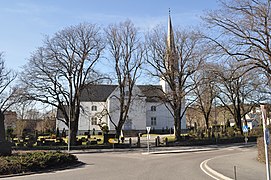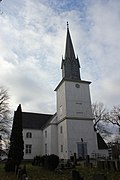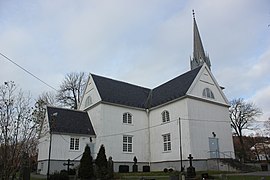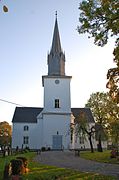Sandar Church
| Sandar Church | |
|---|---|
| Sandar kirke | |
 View of the church | |
 | |
| 59°08′03″N10°13′35″E/ 59.1343036°N 10.226491°E | |
| Location | Sandefjord,Vestfold |
| Country | Norway |
| Denomination | Church of Norway |
| Previous denomination | Catholic Church |
| Churchmanship | Evangelical Lutheran |
| History | |
| Former name(s) | Sandeherred kirke Frederiks kirke |
| Status | Parish church |
| Founded | 1100s |
| Consecrated | 15 Aug 1792 |
| Architecture | |
| Functional status | Active |
| Architect(s) | Hans Christian Lind |
| Architectural type | Cruciform |
| Style | Style Louis XV |
| Completed | 1792 |
| Specifications | |
| Capacity | 700 |
| Materials | Wood |
| Administration | |
| Diocese | Tunsberg |
| Deanery | Sandefjord prosti |
| Parish | Sandar |
| Type | Church |
| Status | Automatically protected |
| ID | 85374 |
Sandar Church(Norwegian:Sandar kirke) is aparish churchof theChurch of NorwayinSandefjord MunicipalityinVestfoldcounty,Norway.It is located in thecity of Sandefjord.It is the church for the Sandarparishwhich is part of theSandefjord prosti(deanery) in theDiocese of Tunsberg.The white, wooden church was built in acruciformdesign in 1792 using plans drawn up by thearchitectHans Christian Lind.The church seats about 700 people.[1][2]
The present church was erected at the ruins of amediaevalstone church from the 12th century. The current church was built in 1792 in theStyle Louis XV.Sandar Church originally had a half-circle dome top, but the roofing was changed to the currentspirein 1868.[3][4]The church was the main church of the oldSandar Municipalityfor a long time until 1968 when it became part ofSandefjord Municipality.The church is located just 300 metres (980 ft) from theSandefjord Church.The old church is only open for advertised church events.[5]
History[edit]
Medieval church[edit]
The earliest existing historical records of the church date back to the year 1345, but the church was not built that year. The first church on this site was a stone church that was likely built in the early 1100s. The old church was known as theSancte Marie Et Sancti Olauichurch because it was dedicated toSaint MaryandSaint Olaf,according to BishopEystein Aslaksson's book from 1398.[6]The church wasconsecratedonSaint FaithDay October 6 (exact year unknown). Although it is most likely dedicated to St. Mary, the mother of Jesus, S. A. Sørensen claims in “Lidt om Sandeherred før i Tiden” (1872) that the church was dedicated toSaint Mary Magdalene.[7]
During excavations in 1901-1902, researchers revealed the original stone church hadapsesand a tower. The church's rectangularnavemeasured 19.2 by 12 metres (63 ft × 39 ft), thechoirmeasured 6.3 by 8 metres (21 ft × 26 ft), and there was achurch porchwith a bell tower above that measured 8.4 by 11.6 metres (28 ft × 38 ft). The total length of the church was estimated to have been 37.6 metres (123 ft). During these excavations, several coins from the early 1100s were recovered which supports the idea that the church was first built around that time. The original stone tower was removed in 1401, but it was later replaced several times. A wooden tower was installed in 1603 after the stone tower was removed for good.[6][8]
After theReformation,the church was known as theSandeherred Churchas it was the church for the Sandeherred parish. When theCounty of Larvikwas established in 1671, the Count became the church owner. On 22 July 1745, lightning struck the church and caused quite a bit of damage to the church. By the latter half of the 18th century the church was described as being in poor condition. It was also too small for the growing population.[8]
Current church[edit]
CountChristian Ahlefeldt-Laurvigdecided that the church needed to be replaced with a larger, more modern church building. Construction plans ran into some problems, however, when the local farmers refused to carry out the compulsory work the Count imposed on them. However, they procured the timber, which was delivered in February 1790. In March of 1790, the old church was torn down. Work on the new wooden,cruciformbuilding began soon after on the same site. The new church was framed and put under roof by the summer of 1791. Construction began under the leadership of a builder named Mr. Horn, who did most of the framing and structural work. He was dismissed after some time and replaced by Hans Christian Lind who finished the project. Lind is often credited especially for the interior work. During the construction process in 1791, Count Christian Ahlefeldt-Laurvig also died, and the title passed to his son Frederik. The church was completed in 1792 and it wasconsecratedon 15 August 1792 by bishopChristen Schmidt.The new church was namedFrederiks Churchin honor ofKing Frederik VI.[9]The new Count Frederik almost went bankrupt in 1805, and the King took over most of the count's estate, but not the churches. Because of this, the churches in the area fell into disrepair.[8]
In 1814, this church served as anelection church(Norwegian:valgkirke).[10][11]Together with more than 300 other parish churches across Norway, it was a polling station for elections to the 1814Norwegian Constituent Assemblywhich wrote theConstitution of Norway.This was Norway's first national elections. Eachchurch parishwas a constituency that elected people called "electors" who later met together in each county to elect the representatives for the assembly that was to meet inEidsvolllater that year.[10][12]
In 1816, an inspection was carried out and it concluded that the church was in a poor condition and some repairs were carried out. The Count continued to have unpaid bills and an insolvent estate, so then in 1835 Frederik Wilhelm Treschow took over ownership of the church and he eventually transferred ownership of the church to the parish.
Outside the church, there is a sculpture depicting priest and poetMagnus Brostrup Landstad.[9]The Landstad sculpture is Norway's first statue made of hard rock. It was unveiled on 17 May 1928 and was made by sculptorHans Holmen.[13]
The church underwent a restoration for 13.4 millionkrfrom November 2020 to July 2021. The restoration was funded by the municipality; theNorwegian Directorate for Cultural Heritage;and donations from private companies, individuals, and nonprofits.[14]
Media gallery[edit]
See also[edit]
References[edit]
- ^"Sandar kirke".Kirkesøk: Kirkebyggdatabasen.Retrieved8 December2023.
- ^"Oversikt over Nåværende Kirker"(in Norwegian). KirkeKonsulenten.no.Retrieved8 December2023.
- ^"Sandar Church".
- ^Philpott, Don (1991).The Visitor's Guide to Norway.Moorland. p. 76.ISBN9780861904242.
- ^"Sandar Church".
- ^abTollnes, Roar L. (1998).Sancte Marie et Sancti Olaui kirke i Sandar(in Norwegian). Sandar historielag.Retrieved27 August2021.
- ^"Sandar kirkested"(in Norwegian).Norwegian Directorate for Cultural Heritage.Retrieved9 December2023.
- ^abc"Sandar kirke".Norges-Kirker.no(in Norwegian).Retrieved9 December2023.
- ^abBertelsen, Hans Kristian (2000).Sandefjord i bilder[Sandefjord in pictures] (in Norwegian). Grafisk studio forlag. p. 83.ISBN8290636024.
- ^ab"Valgkirkene".LokalHistorieWiki.no(in Norwegian).Retrieved8 December2023.
- ^"Valgkartet".Valgene i 1814(in Norwegian). Arkivverket. Archived fromthe originalon 24 June 2021.Retrieved8 December2023.
- ^"Om valgene".Valgene i 1814(in Norwegian). Arkivverket.Retrieved8 December2023.
- ^Tveitan, Flemming Hofmann (8 June 2011)."Landstad".Sandefjords Blad(in Norwegian).Retrieved11 August2021.
- ^Bjerkaas, Vibeke (2021)."Har søkt om to måneder mer til oppussingen".Sandefjords Blad(in Norwegian).Retrieved30 July2021.










